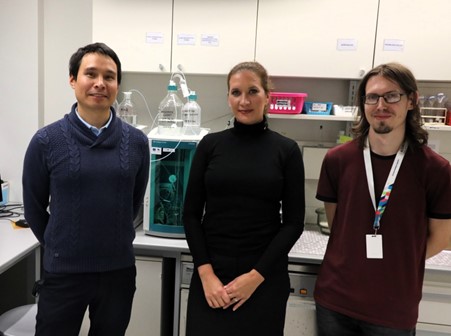Scientists from the University of Tartu and the University of Copenhagen have reached a theoretical description of an ideal electrocatalysis process. If the process could be realized in practice, it would be possible to operate energy conversion and storage devices twice as efficiently.
The world is seeking sustainable solutions to meet the growing energy demand. Recently, scientists from the University of Tartu and the University of Copenhagen proposed a new approach that allows overcoming long-standing limitations in oxygen electrocatalysis.

Catalysis occurs when some accelerating additive, called a catalyst, is added to a chemical reaction. For instance, certain natural proteins or enzymes can make substances react faster with each other. Electrocatalysis also involves an electrode, which is some kind of electrically conductive body. In electrocatalysis, substances start to react with each other on the surface of the electrode.
Oxygen electrocatalysis involves oxygen evolution and reduction reactions. These are extremely important in various electrochemical energy conversion and storage systems, such as water electrolysis, fuel cells, and metal-air batteries.
“These reactions are complex because they involve breaking and forming multiple chemical bonds, which usually have high activation energy. To accelerate these processes, an extremely active catalyst is needed, capable of efficiently lowering these energy barriers and facilitating reactions,” said Nadežda Kongi, the leader of the inorganic functional materials research group (KongiLab) at the University of Tartu and an associate professor.
She noted that overcoming these limitations and accelerating the transition to a hydrogen economy requires a new paradigm for designing catalysts. “Our research group has discovered a way to bypass these theoretical limitations,” she said.
In a recent article published in the Royal Society of Chemistry’s journal Catalysis Science and Technology, the research group introduced an innovative approach: geometry-adaptive electrocatalysis. The approach uses catalysts whose shape changes during the reaction. In this way, the theoretical limitations that have hindered the development of oxygen electrocatalysis for decades can be overcome.
The new method allows bypassing the energy-intensive breaking and forming of chemical bonds in electrocatalysis and instead offers a shortcut (see the diagram below). “This concept could revolutionize the field of oxygen electrocatalysis,” said the main author of the study, Ritums Cepitis, a fourth-year doctoral student at the University of Tartu’s Institute of Chemistry.

Author: Cepitis et al. 2024/Catalysis Science & Technlogy
“Our model shows that ideal catalysis is within reach, and practically, it could potentially double the efficiency of energy conversion and storage technologies,” added Vladislav Ivaništšev, who developed the idea together with Professor Jan Rossmeislig during a postdoctoral fellowship at the University of Copenhagen.
“Now our group in Tartu is ready to implement this approach. Laboratory work requires even more creativity than the modeling stage, but we are already seeing promising progress,” said Kongi.
This article was originally published on the webpage of University of Tartu.
Read more what Research in Estonia has published about energy HERE.
 Back
Back



